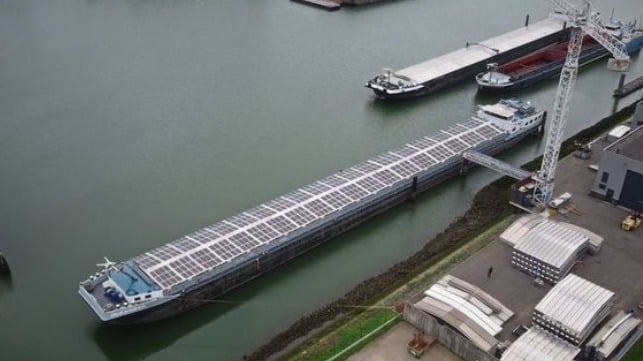Ultra-Thin Solar Panels Deployed on Hatch Covers for Inland Shipping

A Dutch start-up company is working on a novel application of solar panels to make inland shipping vessels operating from Rotterdam more environmentally friendly and sustainable. With access via the Maas and Rhine rivers and links with the Main and Danube that enables transport to the Black Sea, inland shipping is a significant element of the operations from the Port of Rotterdam.
“With the energy transition, we have to make smart use of the space that is available,” says Bo Salet, co-founder of Wattlab. “We are developing new applications for solar energy and generating energy where it is needed.”
Wattlab is developing and designing a broad range of solar power applications. The company is testing prototypes using wafer-thin lightweight solar foils and bendable robust solar panels to flexible panels. In this way, the company says it can make a wide variety of solar panels which meet unique requirements.
“We wished to make inland shipping sustainable and approached Damen to explore the opportunities,” explains Salet. “At the same time, we were approached by a captain who wanted solar panels on his ship. Damen put us in contact with Blommaert Aluminum Constructions, which makes for ship hatches for the shipping industry. Then everything soon came together. In autumn 2020, we operated our first pilot and in late 2020 the solar hatches were commercially available.”
By installing the solar panels on the vessel’s hatches, the company explains that it is using existing space while not interfering with the navigation or cargo operations of the vessel. The panels are generating power for the propulsion of the vessel as well as the operation of systems from navigation to cranes, pumps, and lights and power in the accommodations areas. Solar power can replace the use of diesel generators with the company estimating the financial return for the investment in solar between five and eight years.
On an annual basis, the company estimates the solar panels on one hatch cover can generate 2,900-kilowatt hours. The typical inland vessel is approximately 360 feet long and has 22 hatches. In addition to reducing the consumption of traditional fuels and emissions, Wattlab says solar power also gives the captain the freedom to moor in any location not dependent on shore power connections.
In its first pilot program, Wattlab made a system with lightweight panels on roller shutters that could be deployed over the hatches. Testing showed that because loading and unloading can be rough, the hatches had to be able to withstand rough handling. At the end of last year, the company began a second program concentrating on the more frequently used stackable hatches aboard inland vessels. The challenge was the requirement to minimize the height of the solar panels so as not to impact the stacking capabilities. Wattlab says that in its latest prototype, the solar panels including fixings, all the electrical connections, and other electricals, are within the maximum available height of just 30 millimeters (just over one inch in thickness).
Wattlab is exploring opportunities to fit the panels into newbuilds while it is also suitable for retrofit, so where you replace the old hatches with the solar hatches on existing ships.
